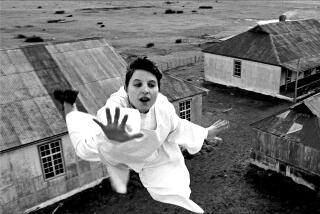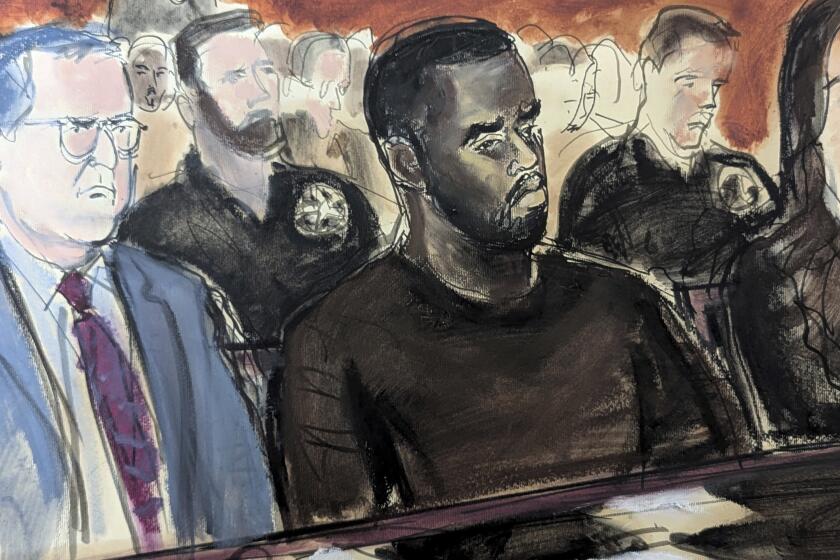Obscure ‘Compass’ Wraps Itself in a Cloak of Beauty
- Share via
“Death and the Compass” is but the latest in a long line of deliberately obscure fables of power and corruption set in a totalitarian future filmed amid settings of architectural grandeur and populated with bizarre, decadent characters.
Watching it is more frustrating than most such exercises in tedium and pretentiousness because it is the work of a talented visionary, Alex Cox, working from a Jorge Luis Borges short story. There’s enough substance here to have allowed Cox to risk letting us know what’s going on.
Ironically, it is said that when the 85-minute film existed in its original 55-minute form, commissioned by the BBC as part of a series of Borges teleplays marking the 500th anniversary of the Spanish invasion of the New World, it was actually more accessible. In any event, much of the additional material consists of a now-retired police commissioner of a vast metropolis, Treviranus (Miguel Sandoval), rambling on and on over his apparent guilt over the fate of one of his outstanding inspectors, Lonnrot (rhymes with Monroe) (Peter Boyle), 45 years earlier.
The heart of the matter is that Lonnrot, investigating serial murders whose sites form a triangle, understandably starts considering whether they have some cabalistic meaning, especially because at each site the killer leaves a curious message behind. When a compass indicates that the killer may be following the pattern of a rhomboid, Lonnrot believes he may be able to capture him before he strikes again.
But are there really “dark forces” at play, or is Lonnrot being set up for some reason? “Death and the Compass” is so hard to follow that it’s difficult to care one way or another. Lost in a thicket of impenetrable developments is any serious commentary on the workings of a police state or the notion of Lonnrot being guilty of hubris, thus triggering his own fate.
“Death and the Compass” looks great, with key Mexico City area locations like the Palacio de Correos, the vast and splendid Beaux Arts central post office and the magnificent Spanish Colonial former Convent of San Ildefonso. It brings to mind Peter Greenaway’s “The Belly of an Architect,” which drew on the ancient splendors of Rome and likewise featured a fine American character actor, Brian Dennehy, and had the dangers of pride as a key theme.
But “Belly,” despite its own pretensions and flaws, works far better than “Death” and afforded Dennehy a much bigger and better role than Boyle got with Lonnrot.
When an admirable risk-taker like Cox succeeds, as he did with his cult film “Repo Man” and “Highway Patrolman” (El Patrullero), he’s great. But when he overreaches and trips up, as in “Walker,” another South of the Border allegory, and in this film--the thud is resounding.
* Unrated. Times guidelines: It includes some strong language and violence.
(BEGIN TEXT OF INFOBOX / INFOGRAPHIC)
‘Death and the Compass’
Peter Boyle: Lonnrot
Miguel Sandoval: Treviranus
Christopher Eccleston: Zunz
Pedro Armendariz Jr.: Blot
Alonso Echanove: Novalis
A Together Brothers release of co-production of Estudios Churubusco Azteca and KHB (Mexico City), PSC (Tokyo) and Together Brothers (Los Angeles). Writer-director Alex Cox. Based on a short story by Jorge Luis Borges. Producers Lorenzo O’Brien and Karl H. Braun. Executive producer Katsumi Ishikuma. Cinematographer Miguel Garzon. Editor Carlos Puente. Costumes Manuela Loaenza and Angela Dobson. Music Pray for Rain. Production designer Cecilia Montiel. Special visual effects Rocco Gioffre. Running time: 1 hour, 25 minutes.
* Exclusively at the Music Hall, 9036 Wilshire Blvd., Beverly Hills, (310) 274-6869.
More to Read
The biggest entertainment stories
Get our big stories about Hollywood, film, television, music, arts, culture and more right in your inbox as soon as they publish.
You may occasionally receive promotional content from the Los Angeles Times.










